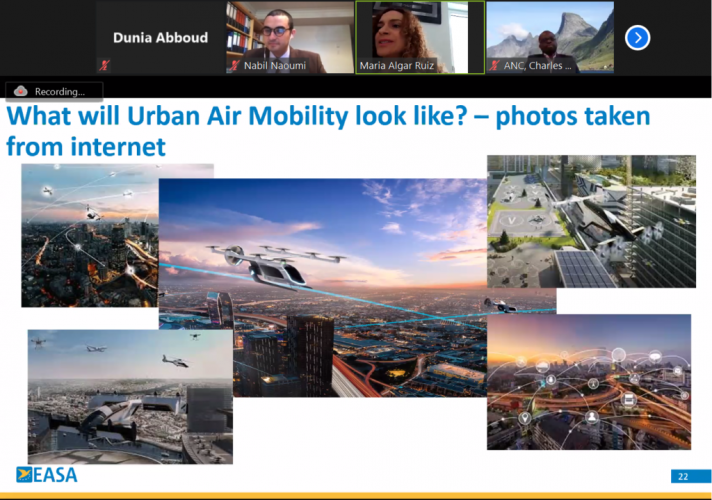ICAO’s Air Navigation Commission (ANC) hosted a discussion with the European Aviation Safety Agency (EASA) and standards agency Eurocae on Urban Air Mobility (UAM) on 20 May 2020. The regulatory bodies were looking at how best to prepare for, respond to and embrace urban air mobility. ICAO commented disruptive innovation exposes national and regional regulators to the risk of falling behind and not being able to improve their working methodology. Another challenge is to meet the existing high, multifaceted expectations of different stakeholders.
Presenters included Jean Marc Cluzeau, Principal advisor to EASA executive director; Maria Algar Ruiz, Programme Manager Drones; Xavier Vergez, EASA senior policy officer, Daniela Defossar, EASA ICAO senior coordinator, Laurent Gruz, EASA representative to ICAO and Canada and Christian Schleifer-Heingaertner, EUROCAE Secretary General.
The general public expects electric and hybrid propulsion to contribute to cleaner skies, that UAM will relieve congestion in city centres, and artificial intelligence will increase safety levels, private investors see an opportunity to develop new businesses. The challenge on the regulatory side, where there is a stable regulatory environment that is quite prescriptive and not fit for dealing with all possible innovations, is that there is a need for creating a more flexible framework while keeping the level of safety as high as it is today, if not higher.
EASA discussed the ways they have been integrating innovation in their work and how they intend to continue to do so in the future. To facilitate this, the European Union Agency identified six pillars:
- The first pillar is to organize innovation as part of their business. This is reached with the creation of an innovation cell, whose role finds its importance in the coordination of all activities dealing with disruptive innovations. This cell is also responsible for seeking solutions by identifying specific actions that should be taken, both internally and externally.
- The second pillar is to be technology agnostic and move towards more performance-based regulation.
- The third adapts the Agency’s methodologies, with the typical example of AI given. EASA has been working on new methodologies to certify new developments.
- The fourth pillar involves engagement with new entrants. Indeed, the landscape of stakeholders of the Agency has been changed radically with a fairly high number of new players developing new products, new business models and services, and requests to collaborate with EASA. It is important for the Agency to have the capacity to take them on board for two main reasons: to help such stakeholders develop their aviation safety culture, considering some do not have a mature aviation safety culture which often leads them to minimize the aviation safety risk; the second aspect is that EASA wants to learn from these organizations since many of them are at the edge of innovation and from which the Agency can benefit.
- The fifth pillar is to learn from the industry in order to avoid any knowledge gap between regulators and the industry.
- The sixth pillar is to integrate innovation as a corporate value. This has been reached through the creation of an internal network comprising 20% of the Agency staff with the purpose of sharing innovation knowledge.
Innovation is moving so fast that regulators like EASA must anticipate the developments of competencies of their experts or they will expose themselves to the risk that their experts will not have the necessary competencies to conduct a proper assessment of new technologies. To reach the required level of knowledge of new innovations as early as possible, the Agency has been working with innovative industry players by setting partnerships ahead of the development of new products or certifications.
For more information visit:




